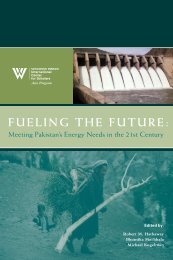Environmental Change and Security Project Report - Woodrow ...
Environmental Change and Security Project Report - Woodrow ...
Environmental Change and Security Project Report - Woodrow ...
You also want an ePaper? Increase the reach of your titles
YUMPU automatically turns print PDFs into web optimized ePapers that Google loves.
1000 live births, <strong>and</strong> the mortality rate for children<br />
under age five is 171 per 1000 live births<br />
(World Bank, 2004). Malnutrition is a chronic<br />
problem: more than half of children under five<br />
years are stunted, while 47 percent are underweight<br />
(UNICEF, 2004). According to the<br />
World Food Program (2004), the average daily<br />
calorie intake of the population (2,037 per day)<br />
lags behind the minimum recommended intake<br />
of 2,300 calories.<br />
Ethiopia’s health infrastructure is not keeping<br />
pace with population growth. A recent<br />
report from the World Bank <strong>and</strong> Ethiopia’s<br />
Ministry of Health (2004) affirms that at the<br />
current pace, achieving the child survival objective<br />
of the Millennium Development Goals will<br />
be challenging.<br />
• Only about 40 percent of the population<br />
lives within five kilometers (one hour’s walk)<br />
of a health facility;<br />
• The ratio of health professionals is extremely<br />
low: the three largest regions have only one<br />
doctor per 55,000 people, one nurse per<br />
10,000 people, <strong>and</strong> one midwife per<br />
100,000 people; <strong>and</strong><br />
• Vector-borne diseases (usually relatively easy to<br />
control) affect more than 10 percent of the<br />
population.<br />
And the HIV/AIDS p<strong>and</strong>emic is now a<br />
major public health problem: although<br />
Ethiopia represents 1 percent of the world’s<br />
population, the estimated 1.5 million living<br />
with the virus equals 4 percent of the world’s<br />
HIV/AIDS sufferers in 2003 (UNAIDS,<br />
2004). HIV/AIDS is damaging the country’s<br />
socio-economic fiber: more than 90 percent of<br />
those infected are between the ages of 15 <strong>and</strong><br />
49—the most productive segment of society—<br />
<strong>and</strong> 720,000 children have been orphaned<br />
(UNAIDS, 2004). 5<br />
Population, Development, <strong>and</strong> the<br />
Environment<br />
Ethiopia’s unsustainable population growth contributes<br />
not only to its dire economic <strong>and</strong> social<br />
situation, but also to the country’s environmental<br />
degradation, especially in the densely populated<br />
highl<strong>and</strong>s. These sloping l<strong>and</strong>s, occupied since<br />
time immemorial, are severely deforested, overcultivated,<br />
eroded, <strong>and</strong> nutrient-poor. Dr. Assefa<br />
Hailemariam (2003), a demographer <strong>and</strong> development<br />
specialist, cites a 1978 study by K. J.<br />
Virgo <strong>and</strong> R. N. Munro to illustrate the problem’s<br />
roots: “Reconnaissance soil surveys covering<br />
6000 km 2 in the Central Plateau region, at elevations<br />
of 2000-2800 meters above sea level, have<br />
found that all the l<strong>and</strong> that is physically cultivable<br />
is now cultivated. The only l<strong>and</strong>s not cultivated<br />
are in depressions <strong>and</strong> on steep rocky slopes.”<br />
As the population grows <strong>and</strong> people overcultivate<br />
scarce l<strong>and</strong>, its nutrient value is reduced<br />
<strong>and</strong> erosion takes it toll. An expert panel<br />
(Teketay, Fetene, & Abate, 2003) recently<br />
reported that erosion has seriously degraded<br />
over 50 percent of Ethiopia’s arable l<strong>and</strong> <strong>and</strong><br />
projected a grim future:<br />
While the soils in the Ethiopian highl<strong>and</strong>s<br />
have a high inherent fertility, the continuous<br />
removal of nutrients without replacement<br />
as well as the steep <strong>and</strong> dissected<br />
terrain with extensive areas of slopes of<br />
over 15 percent, coupled with the high<br />
intensity of rainfall, have led to accelerated<br />
soil erosion reaching up to 400<br />
tons/hectares/annum.….About 20,000-<br />
30,000 hectares of cropl<strong>and</strong> in the highl<strong>and</strong>s<br />
are being ab<strong>and</strong>oned annually since<br />
cropping can no longer be supported by<br />
the soil. It is projected that l<strong>and</strong> degradation<br />
at the present rates could destroy the<br />
farml<strong>and</strong>s of some 10 million highl<strong>and</strong><br />
farmers by 2010. (page 12).<br />
Population, deforestation, <strong>and</strong> erosion are<br />
part of a vicious cycle: Hailemariam (2003) notes<br />
that less than three percent of the country is currently<br />
forested <strong>and</strong> points out, “As population<br />
pressure increases, particularly in the highl<strong>and</strong>s,<br />
farmers intensively exercise deforestation. This<br />
will leave farml<strong>and</strong>s <strong>and</strong> grazing l<strong>and</strong>s exposed to<br />
erosion, followed by massive l<strong>and</strong> degradation”<br />
(page 9). At the current rate of deforestation of<br />
over 150,000-200,000 hectares per year, it will<br />
45<br />
SPECIAL REPORT • POPULATION, DEVELOPMENT, AND ENVIRONMENT IN ETHIOPIA

















